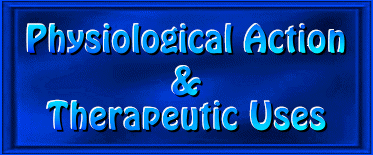

The following is excerpted from The Professional's Herbal Formula Handbook No. 6, comprising 85 pages of traditional information and recent scientific data that describes the medical properties, physiological action and therapeutic uses for each of the 24 ingredients outlined in this formula.




Adaptogenic, alterative, anabolic, anti-aggregant (venous or arterial thrombi), anti-anemic, antibiotic, anti-cachexic, anti-dyscratic, antioxidant, antiphlogistic (anti-inflammatory), antiseptic, bacteriostatic (anti-bacterial), biocatalyst, cell proliferant, cytophylactic, cytotoxic, disinfectant, eutrophic, immuno-potentiating, immuno-stimulant, microbicidal (anti-microbial), rejuvenative, restorative, stimulant (circulatory and secretolytic), tonic, vasodilator, vasotonic and viricidal (anti-viral).


Alleviates any general fluids dyscrasia
(abnormal or pathological condition) within the blood vessels or
musculature that leads to the onset of degenerative or
debilitative conditions associated with various forms of anemia
or anemic disorders (including aplastic, cerebral, hypochromic,
nutritional, pernicious or sickle cell), and eliminates any form
of cachexia (state of malnourishment and general debility)
throughout the blood vessels and musculature; displays
significant antioxidant effects in order to enhance the transport
of additional oxygen directly into the cells and tissue-systems
throughout the blood vessels (due to lowered hemoglobin levels in
the blood), and removes any chronic fatigue or exhaustion
associated with various form of anemia or anemic conditions
throughout the blood vessels, tissue-systems, or musculature;
relieves any chronic arterial obliteration, arterial circulatory
disturbances, sclerosis of the cerebral arteries, or cerebral
vascular and nutritional insufficiency, and reduces any pain
associated with obstructive arteriopathy; prevents the formation
of any peripheral arterial or vascular insufficiency (lack of
adequate blood supply to the extremities) or peripheral
arteriopathy (arterial insufficiency of the lower extremities),
and reduces any cramping sensations or numbness throughout the
extremities; eliminates any other vascular peripheral disorders,
such as Raynaud's syndrome (a vaso-spastic disorder characterized
by pallor and cyanosis of the fingers), acrocyanosis,
postphlebitis syndrome, or obliterative arterial disease (a
vascular disorder in the lower extremities); removes any
sensitivity to cold or pallor in the lower extremities
(especially the toes), due to peripheral circulatory
insufficiency; alleviates any intermittent claudications (painful
leg cramps) associated with arterial insufficiency (reduction of
blood flow to a specific area) that leads to hypoxia (oxygenation
deficiencies), which increases the production of toxic
metabolites and cellular free radicals; prevents the formation of
any metabolic or neuronal disturbances in those conditions
involving cerebral ischemia and hypoxia by enhancing the
utilization of oxygen and increasing the cellular absorption of
glucose, thereby restoring aerobic glycolysis; provides
prophylactic protection against any transient ischemic attacks by
increasing cerebral blood flows and oxygen or glucose
utilization, and eliminates any cerebral impairment associated
with vascular or degenerative conditions; removes any cerebral
vascular insufficiency (geriatric dementia) associated with
lowered vitality or anemic conditions (cerebral anemia), and
increases the tone of the capillaries that transport blood
directly to the brain tissues; produces balanced activity upon
the arterial and venous systems by exerting or restoring greater
tonicity and increased circulatory flows in those inconditions
involving vasomotor paralysis, as well as relaxant effects upon
the arteries and arterioles in order to counteract any vascular
or vasomotor spasms in those conditions involving cerebral
insufficiency; alleviates any focal or diffuse cerebral vascular
disease, and increases the number of appropriate cholinergic
receptor sites in the brain in order to revitalize any
decreasingly ineffective cerebral tissues; exhibits a direct
effect upon endothelial cells in order to enhance greater blood
flow throughout the arteries and veins without any alteration in
systemic blood pressure, and displays vasodilator activity by
directly stimulating the release of various endogenous relaxing
factors in the arterial endothelium (such as endothelium-derived
relaxing factor [EDRF] and prostacyclin); provides direct
membranal and antioxidant effects in order to significantly
reduce any platelet aggregation, adhesion or degeneration by
stabilizing the platelet's membranes, scavenging any damaging
free radicals, increasing the synthesis of prostacyclin,
inhibiting the enzyme phosphodiesterase, and antagonizing the
platelet activating factor (PAF-acether), and displays potent
inhibitory effects against the platelet activating factor (known
as ginkgolide B>A>C) by competing with PAF-acether for
binding (or receptor) sites; stimulates the synthesis of
prostaclycin, which is the natural anti-aggretory prostaglandin
that is synthesized by the vascular endothelium (the cellsthat
line the inside of the blood vessel); activates the membranal
enzyme Na + K + ATP-ase (or sodium pump) that is responsible for
the exchange of intracellular sodium for extracellular potassium,
thereby improving the process of membranal polarization;
stimulates the release of various chemical neurotransmitters
known as catecholamines (epinephrine and norepinephrine), thereby
improving the functional capabilities of the entire network of
catecholaminergic glandular, cardiovascular and nervous systems
throughout the entire organism; alleviates any severe
cochleovestibular disturbances associated with certain vascular
dysfunctions, and increases the perfusion rate to various areas
of the vascular system (e.g., arterial, arteriolar,
microcirculatory, venular and venous components); displays
antioxidant properties in order to inhibit any systemic organ or
tissue damage from potentially dangerous chemicals known as free
radicals, as well as to remove these chemicals from the entire
organism; acts as an extremely effective inhibitor of any lipid
peroxidation in various cellular membranes that is directly
induced by oxygenated free radicals, and prevents any cellular
damage from excessive free radicals that are generated during
chronic activation of the immune system; prevents any free
radical damage to all the cellular tissue and organs throughout
the body, due to the presence of (1) heteroside flavonoids
(quercetin, kaempferol and isorhamnetin), (2) coumarin esters of
quercetin, kaempferol and glucorhamnoside, (3) proanthocyanidins
(ionized flavonoids), and (4) catechins; stabilizes the cellular
membranes, which are fluid barriers or defense mechanisms against
any form of cellular invasion; provides greater tonicity to the
vein that is essential to the dynamic elimination of various
toxic metabolites that accumulate during lowered oxygen levels,
and protects against any damage to the blood vessel walls by
inhibiting the release of certain enzymes in such a manner that
leads to smooth muscle cell relaxation in the walls of the blood
vessels; exhibits vascular effects primarily by directly
affecting the cells that line the blood vessel, and by enhancing
the tonicity of the smooth muscle cells of the vessel; improves
the quality and quantity of the microcirculation, thereby
increasing circulatory flows to all the vital tissues and organs
(such as the heart and brain); exhibits cytophylactic and
cytotoxic activity in order to provide stronger cellular defense
mechanisms against many physical or chemical agents, and displays
anti-infective and disinfectant properties in order to promote
increased resistance by destroying any invasive or harmful
pathogenic bacteria, microbes or viruses that are often
responsible for various infectious states or inflammatory
conditions; exhibits bacteriostatic, microbicidal and viricidal
activity in order to strengthen and increase the resistance of
the arteries, blood vessels and capillaries against any invasive
or harmful bacteria or microbes, as well as to inhibit the
further development of any infectious or inflammatory conditions
associated with the onset of sepsis, septicemia or uremia;
demonstrates significant antiphlogistic effects in order to
inhibit the formation of certain inflammatory compounds (such as
histamine, leukotrienes, prostaglandin, serine proteases and
thromboxanes), as well as to reduce any severe inflammatory
swelling associated with sepsis, septicemia or uremia by exerting
an extremely positive influence towards correcting any internal
inflammatory conditions within the arteries, blood vessels or
capillaries; exhibits significant antiseptic activity by
destroying the vitality of any organized living ferments in order
to prevent the onset of putrefaction or septicemia, and
precipitates the proteins in any inflamed tissues in order to
provide a mildly antiseptic and protective coating (under which
the regeneration of new tissue occurs) for the arteries, blood
vessels and capillaries throughout the entire organism; acts as
an effective antiseptic in order to remove any septic conditions
associated with tissue degeneration or ulceration, and promotes
increased suppuration and a steady toning or restorative
impression to the entire glandular system (especially the liver,
spleen and lymph glands); acts as a biocatalyst in order to
directly affect the expenditure of energy-reserves that are
stored in muscle ATP, thereby allowing for increased weight gain
and improved skeletal muscle tone; displays biocatalytic activity
in order to enhance greater assimilation of those essential
nutrients that are necessary for the increased production of
energy and vitality, thereby accelerating certain rejuvenative
processes associated with the repair of any damaged muscle or
connective tissues throughout the entire organism; acts as a
biocatalyst in order to accelerate and accentuate the transport
of all the other herbal ingredients throughout the entire
organism to specific areas of the body (especially the blood
vessels and musculature), and exhibits circulatory stimulant
activity in order to permeate the entire organism (both
internally and externally) with greater warmth and movement by
supporting the innate warmth that resides in the blood and muscle
tissues; acts as a cell proliferant in order to stimulate
increased cellular mitosis (cell division and reproduction) in an
adequate nutritional environment, as well as to accelerate the
healing processes by promoting increased granulation and greater
resolution during the repair of any damaged blood vessels or
musculature; displays cell proliferant activity in order to
inhibit the normal aging process within the blood vessels or
muscles, thereby extending the overall lifespan of the various
cells and tissue-systems throughout the entire organism; exhibits
anabolic activity in order to accelerate the production of DNA
and RNA (which enhances the production of proteins in the form of
antibodies), while increasing protein and lipid synthesis in the
bone marrow and DNA/RNA content in the adrenals and lymph nodes
(along with increased body weight and enhanced re-synthesis of
glycogen and high-energy phosphate compounds); demonstrates
powerful adaptogenic (balancing and strengthening) activity in
order to increase the overall resistance of an organism towards
any adverse influences or stressful conditions (whether they be
physical, chemical or biological in nature), especially upon the
blood vessels, musculature, immune system, and both the central
(cerebro-spinal centers) and peripheral nervous systems; exhibits
immuno-potentiating and immuno-stimulatory effects in order to
enhance greater long-term immune potential and
overallnon-specific systemic immunity (or immune cell activity)
and increased immune response (by activating the body's natural
defense mechanisms), particularly in relation to the repair and
restoration of any damaged muscles or connective tissues
throughout the entire organism; enhances greater cellular energy
production by beneficially affecting the various intracellular
components, and exhibits circulatory stimulant activity in order
to permeate the entire organism (both internally and externally)
with greater warmth and movement by supporting the innate warmth
that resides in the blood and muscle tissues; acts as a
secretolytic stimulant in order to promote increased gastric,
pancreatic or intestinal secretory and motor activity, and
enhances greater peripheral circulation (due to its antioxidant
activity); exhibits significant antioxidant effects in order to
provide greater oxygen-transport capabilities throughout the
bloodstream, as well as enhance the transport of additional
oxygen directly into the cells and tissue-systems throughout the
blood vessels and musculature; acts as a circulatory stimulant by
increasing the blood flows through the arteries and blood vessels
of the muscles in order to enhance greater nutrient transport,
absorption and utilization, thereby accelerating the healing
processes associated with the repair of any damaged blood vessels
or tissue-systems throughout the entire musculature; displays
significant rejuvenative and restorative properties upon the
basic plasma tissue-systems throughout the entire organism,
thereby enhancing the production of vital bodily fluids while
providing greater enrichment through increased assimilation of
the various organic mineral salts; acts as an eliminative
vasotonic to the blood, liver and splenic functions, as well as
upon the eliminative functions of the lymphatic system; displays
alterative activity in order to correct any disordered bodily
function, thereby activating increased alterations in both
metabolic and tissue functions as a defensive measure against the
onset of acute or chronic disease; exhibits restorative effects
in order to regain increased vigor or vitality and greater
strength, while enhancing normal tissue and metabolic functional
capabilities; demonstrates alterative and restorative properties
in order to re-establish healthy systemic functional
capabilities, as well as to establish greater vascular tone
throughout the entire organism (due to its ability to stimulate
increased secretory flows); exhibits alterative effects in order
to stimulate the anabolic growth processes, thereby enhancing the
repair of any degenerated, deteriorated and debilitated cells or
tissues (while promoting the elimination of any catabolic waste
materials); displays tonifying effects in order to permanently
enhance the overall energy-levels throughout the entire organism,
without adversely affecting the functional capabilities of any
particular organ or system.
![]()
None.
![]()